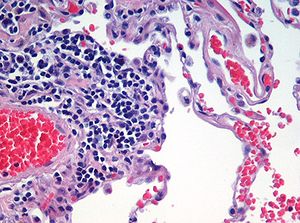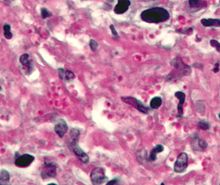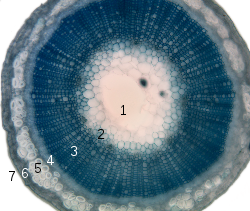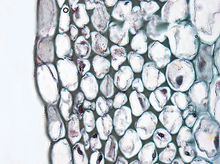- Tissue (biology)
-
This article is about biological tissue. For other uses, see Tissue.
 Cross section of sclerenchyma fibers in plant ground tissue
Cross section of sclerenchyma fibers in plant ground tissue
Tissue is a cellular organizational level intermediate between cells and a complete organism. A tissue is an ensemble of cells, not necessarily identical, but from the same origin, that together carry out a specific function. These are called tissues because of their identical functioning. Organs are then formed by the functional grouping together of multiple tissues.
The study of tissue is known as histology or, in connection with disease, histopathology. The classical tools for studying tissues are the paraffin block in which tissue is embedded and then sectioned, the histological stain, and the optical microscope. In the last couple of decades, developments in electron microscopy, immunofluorescence, and the use of frozen tissue sections have enhanced the detail that can be observed in tissues. With these tools, the classical appearances of tissues can be examined in health and disease, enabling considerable refinement of clinical diagnosis and prognosis.
Contents
Animal tissues
Animal tissues can be grouped into four basic types: connective, muscle, nervous, and epithelial. Multiple tissue types comprise organs and body structures. While all animals can generally be considered to contain the four tissue types, the manifestation of these tissues can differ depending on the type of organism. For example, the origin of the cells comprising a particular tissue type may differ developmentally for different classifications of animals. The epithelium in all animals is derived from the ectoderm and endoderm with a small contribution from the mesoderm which forms the endothelium. By contrast, a true epithelial tissue is present only in a single layer of cells held together via occluding junctions called tight junctions, to create a selectively permeable barrier. This tissue covers all organismal surfaces that come in contact with the external environment such as the skin, the airways, and the digestive tract. It serves functions of protection, secretion, and absorption, and is separated from other tissues below by a basal lamina. Endothelium, which comprises the vasculature, is a specialized type of epithelium.
Connective tissue
Connective tissues are fibrous tissues. They are made up of cells separated by non-living material, which is called extracellular matrix. Connective tissue gives shape to organs and holds them in place. Both blood and bone are examples of connective tissue. As the name implies, connective tissue serves a "connecting" function. It supports and binds other tissues. Unlike epithelial tissue, connective tissue typically has cells scattered throughout an extracellular matrix.
Muscle tissue
Muscle cells form the active contractile tissue of the body known as muscle tissue. Muscle tissue functions to produce force and cause motion, either locomotion or movement within internal organs. Muscle tissue is separated into three distinct categories: visceral or smooth muscle, which is found in the inner linings of organs; skeletal muscle, in which is found attached to bone providing for gross movement; and cardiac muscle which is found in the heart, allowing it to contract and pump blood throughout an organism..
Nervous tissue
Cells comprising the central nervous system and peripheral nervous system are classified as neural tissue. In the central nervous system, neural tissue forms the brain and spinal cord and, in the peripheral nervous system forms the cranial nerves and spinal nerves, inclusive of the motor neurons. Transmits communications.
Epithelial tissue
The epithelial tissues are formed by cells that cover organ surfaces such as the surface of the skin, the airways, the reproductive tract, and the inner lining of the digestive tract. The cells comprising an epithelial layer are linked via semi-permeable, tight junctions; hence, this tissue provides a barrier between the external environment and the organ it covers. In addition to this protective function, epithelial tissue may also be specialized to function in secretion and absorption. Epithelial tissue helps to protect organisms from microorganisms, injury, and fluid loss.
Plant tissues
Examples of tissue in other multicellular organisms are vascular tissue in plants, such as xylem and phloem. Plant tissues are categorized broadly into three tissue systems: the epidermis, the ground tissue, and the vascular tissue. Together they are often referred to as biomass.
- Epidermis - Cells forming the outer surface of the leaves and of the young plant body.
- Vascular tissue - The primary components of vascular tissue are the xylem and phloem. These transport fluid and nutrients internally.
- Ground tissue - Ground tissue is less differentiated than other tissues. Ground tissue manufactures nutrients by photosynthesis and stores reserve nutrients.
Plant tissues can also be divided differently into two types:
- Meristematic tissues
- Permanent tissues
Meristematic tissues
Meristematic tissue consists of actively dividing cells, and leads to increase in length and thickness of the plant. The primary growth of a plant occurs only in certain, specific regions, such as in the tips of stems or roots. It is in these regions that meristematic tissue is present. Cells in these tissues are roughly spherical or polyhedral, to rectangular in shape, and have thin cell walls. New cells produced by meristem are initially those of meristem itself, but as the new cells grow and mature, their characteristics slowly change and they become differentiated as components of the region of occurrence of meristimatic tissues, they are classified as:
-
- a) Apical Meristem - It is present at the growing tips of stems and roots and increases the length of the stem and root. They form growing parts at the apices of roots and stems and are responsible for increase in length,also called primary growth.This meristem is responsible for the linear growth of an organ.
-
- b) Lateral Meristem - This meristem consist of cells which mainly divide in one plane and cause the organ to increase in diameter and growth. Lateral Meristem usually occurs beneath the bark of the tree in the form of Cork Cambium and in vascular bundles of dicots in the form of vascular cambium. The activity of this cambium results in the formation of secondary growth.
The cells of meristematic tissues are similar in structure and have thin and elastic primary cell wall made up of cellulose. They are compactly arranged without inter-cellular spaces between them. Each cell contains a dense cytoplasm and a prominent nucleus. Dense protoplasm of meristematic cells contains very few vacuoles. Normally the meristematic cells are oval, polygonal or rectangular in shape.
Meristemetic tissue cells have a large nucleus with small or no vacuoles, they have no inter cellular spaces.
Permanent tissues
The meristematic tissues that take up a specific role lose the ability to divide. This process of taking up a permanent shape, size and a function is called cellular differentiation. Cells of meristematic tissue differentiate to form different types of permanent tissue. There are 2 types of permanent tissues:
1. simple permanent tissues
2. complex permanent tissues
Simple permanent tissues
These tissues are called simple because they are composed of similar types of cells which have common origin and function. They are further classified into:
- Parenchyma
- Collenchyma
- Sclerenchyma
- Epidermis
Parenchyma
It consists of relatively unspecialised cells with thin cell walls. They are live cells. They are usually loosely packed, so that large spaces between cells(intercellular spaces)are found in this tissue. This tissue provides support to plants and also stores food.In some situations , it contains chlorophyll and performs photosynthesis, and then it is called chlorenchyma. In aquatic plants,large air cavities are present in parenchyma to give support to them to float on water. Such a parenchyma type is called aerenchyma.
Collenchyma
Collenchyma is Greek word where "Collen" means gum and "enchyma" means infusion. It is a living tissue of primary body like Parenchyma. Cells are thin-walled but possess thickening of cellulose and pectin substances at the corners where number of cells join together. This tissue gives a tensile strength to the plant and the cells are compactly arranged and do not have inter-cellular spaces. It occurs chiefly in hypodermis of stems and leaves. It is absent in monocots and in roots.
Collenchymatous tissue acts as a supporting tissue in stems of young plants. It provides mechanical support, elasticity, and tensile strength to the plant body. It helps in manufacturing sugar and storing it as starch. It is present in margin of leaves and resist tearing effect of the wind.
Sclerenchyma
Sclerenchyma is Greek word where "Sclrenes" means hard and "enchyma" means infusion. This tissue consists of thick-walled, dead cells. These cells have hard and extremely thick secondary walls due to uniform distribution of lignin. Lignin deposition is so thick that the cell walls become strong, rigid and impermeable to water. Sclerenchymatous cells are closely packed without inter-cellular spaces between them. Thus, they appear as hexagonal net in transverse section. The cells are cemented with the help of lamella. The middle lamella is a wall that lies between adjacent cells. Sclerenchymatous cells mainly occur in hypodermis, pericycle, secondary xylem and phloem. They also occur in endocorp of almond and coconut. It is made of pectin, lignin, protein. The cells of sclerenchymatous cells can be classified as :
- Fibres- Fibres are long, elongated sclerenchymatous cells with pointed ends.
- Sclerides- Sclerenchymatous cells which are short and possess extremely thick, lamellated, lignified walls with long singular piths. They are called sclerides.
The main function of Sclerenchymatous tissues is to give support to the plant.
Epidermis
The entire surface of the plant consists of a single layer of cells called epidermis or surface tissue. The entire surface of the plant has this outer layer of epidermis. Hence it is also called surface tissue. Most of the epidermal cells are relatively flat. the outer and lateral walls of the cell are often thicker than the inner walls. The cells forms a continuous sheet without inter cellular spaces. It protects all parts of the plant.
Complex permanent tissue
A complex permanent tissue may be classified as a group of more than one type of tissue having a common origin and working together as a unit to perform a function. These tissues are concerned with transportation of water, mineral, nutrients and organic substances. The important complex tissues in vascular plants are xylem, phloem.
Xylem
Xylem is a chief, conducting tissue of vascular plants. It is responsible for conduction of water and mineral ions.
Xylem is a very important plant tissue as it is part of the ‘plumbing’ of a plant. Think of bundles of pipes running along the main axis of stems and roots. It carries water and dissolved substances throughout and consists of a combination of parenchyma cells, fibers, vessels, tracheids and ray cells. Long tubes made up of individual cells are the vessels, while vessel members are open at each end. Internally, there may be bars of wall material extending across the open space. These cells are joined end to end to form long tubes. Vessel members and tracheids are dead at maturity. Tracheids have thick secondary cell walls and are tapered at the ends. They do not have end openings such as the vessels. The tracheids ends overlap with each other, with pairs of pits present. The pit pairs allow water to pass from cell to cell. While most conduction in the xylem is up and down, there is some side-to-side or lateral conduction via rays. Rays are horizontal rows of long-living parenchyma cells that arise out of the vascular cambium. In trees, and other woody plants, ray will radiate out from the center of stems and roots and in cross-section will look like the spokes of a wheel.
Phloem
Phloem is an equally important plant tissue as it also is part of the ‘plumbing’ of a plant. Primarily, phloem carries dissolved food substances throughout the plant. This conduction system is composed of sieve-tube member and companion cells, that are without secondary walls. The parent cells of the vascular cambium produce both xylem and phloem. This usually also includes fibers, parenchyma and ray cells. Sieve tubes are formed from sieve-tube members laid end to end. The end walls, unlike vessel members in xylem, do not have openings. The end walls, however, are full of small pores where cytoplasm extends from cell to cell. These porous connections are called sieve plates. In spite of the fact that their cytoplasm is actively involved in the conduction of food materials, sieve-tube members do not have nuclei at maturity. It is the companion cells that are nestled between sieve-tube members that function in some manner bringing about the conduction of food. Sieve-tube members that are alive contain a polymer called callose. Callose stays in solution as long at the cell contents are under pressure. As a repair mechanism, if an insect injures a cell and the pressure drops, the callose will precipitate. However, the callose and a phloem protein will be moved through the nearest sieve plate where they will form a plug. This prevents further leakage of sieve tube contents and the injury is not necessarily fatal to overall plant turgor pressure. Phloem transports food and materials in plants in upwards and downwards as required.
See also
References
- Raven, Peter H., Evert, Ray F., & Eichhorn, Susan E. (1986). Biology of Plants (4th ed.). New York: Worth Publishers. ISBN 0-87901-315-X.
External links
Human systems and organs TA 2–4:
MSBone (Carpus · Collar bone (clavicle) · Thigh bone (femur) · Fibula · Humerus · Mandible · Metacarpus · Metatarsus · Ossicles · Patella · Phalanges · Radius · Skull (cranium) · Tarsus · Tibia · Ulna · Rib · Vertebra · Pelvis · Sternum) · CartilageTA 5–11:
splanchnic/
viscusmostly
Thoracicmostly
AbdominopelvicDigestive system+
adnexaMouth (Salivary gland, Tongue) · upper GI (Oropharynx, Laryngopharynx, Esophagus, Stomach) · lower GI (Small intestine, Appendix, Colon, Rectum, Anus) · accessory (Liver, Biliary tract, Pancreas)TA 12–16 Blood
(Non-TA)General anatomy: systems and organs, regional anatomy, planes and lines, superficial axial anatomy, superficial anatomy of limbs Plants Biosphere > Ecosystem > Community (Biocoenosis) > Population > Organism > Organ system > Organ > Tissue > Cell > Organelle > Molecule (Macromolecule · Biomolecule) > AtomCategories:- Tissues
Wikimedia Foundation. 2010.




